
Update on Lead Testing Requirements for School Districts
Jan 19, 2018
Share to:
In August of 2017, the Governor signed Public Act 100-103 which amended 225 ILCS 320/35.5, the law requiring school districts to collect and test samples of potable water at certain schools. We previously issued a law alert which addressed the basic requirements and legal issues under Section 35.5. Beyond the basics, the amended statute leaves open several important practical considerations related to testing, mitigation, and the enforcement of the statute. Many of these technical issues can be discussed with the laboratories that provide the testing services, or with your attorney. This update addresses the practical implications of Public Act 100-103, and provides guidance on compliance.
1. What did P.A. 100-103 change about the statute?The Act amended the statue’s requirements for laboratories that perform testing on the water. The statute now requires laboratories to be certified to analyze lead in drinking water in accordance with accreditation requirements developed by a national laboratory accreditation body. The statute previously required the laboratories to be accredited by the Illinois Environmental Protection Agency. The Act, as amended, also requires laboratories to analyze the samples in accordance with the requirements of a national laboratory accreditation body, including one of the testing methods described in federal EPA regulations. The Illinois Department of Health (“IDPH”) also issued a memorandum to the Illinois EPA, Division of Labs, requiring that all testing for this law use a minimum reporting limit of 2.0 parts per billion (ppb).
2. How many samples of water must be taken? Only two samples from each source of potable water are required. School districts must collect at a minimum a 250 milliliter sample of water from each source of potable water that has been standing in the plumbing pipes for at least 8 hours, but not more than 18 hours, without any flushing of the source. A second sample of 250 milliliters must be collected after a thirty second flush from the time of the first collection. If any of the sources of potable water utilize the same drain, the school district is only required to have two samples for one source of water, and one sample for the remaining sources.
3. What if the school district’s lead results show a positive presence for lead? Section 35.5 only addresses positive lead samples if the presence of lead exceeds 5.0 ppb. If any of the samples exceed the 5.0 ppb threshold, the statute requires school districts to promptly provide individual notification of the sampling results, via written or electronic notification, to the parents and legal guardians of all students enrolled at that facility. The notification must include the sampling locations and the United States Environmental Protect Agency’s website for information about lead in drinking water.
4. What if only the first sample of water has results over 5.0 ppb? The school district must still comply with the notification requirements under the statute. There is no exception to the notification requirement, even if the second sample is below 5.0 ppb. 5. What is required if all of a school district’s lead results are below 5.0 ppb? The statute also states that if the test results are under 5.0 ppb, a school district “may”give the individual notification or post the results on the school’s website. Although Section 320/35.5 does not explicitly mandate notification if the results are under 5.0 ppb, the IDPH’s Sampling Protocol for Drinking Water in Schools states that a school district must at a minimum provide notification through its website, even when results are under 5.0 ppb.
6. Do school districts need to mitigate or remediate positive lead results?The statute does not require school districts to mitigate any positive lead results, or impose any penalties if a school district fails to comply with the statute. Rather, the statute requires IDPH to post on its website guidance on mitigation actions and ongoing water practices in schools. IDPH’s “School Mitigation Strategies for Lead in Drinking Water“, acknowledges that the law does not require mitigation, but states that IDPH is requiring the mitigation strategies and requirements contained in the document until subsequent testing indicates no presence of lead. Although the statute does not give IDPH the regulatory power to enforce or require the mitigation strategies, school districts should use the IDPH’s guidelines to protect their students and staff from lead exposure, and also prevent any potential regulatory actions by IDPH or civil lawsuits. We also anticipate that IDPH may publish a list of school districts that have not complied with this Act. IDPH’s recommendations for reducing lead levels include monitoring and sequential sampling of problem fixtures, installation of mechanical flushing valves, manually flushing fixtures, and removal and replacement of fixtures with persistent lead levels.
7. Are high schools or community colleges with day care centers or pre-kindergarten programs subject to the testing requirements?The statute only applies to school buildings constructed before January 1, 2000 that are occupied by 10 or more children or students, pre-kindergarten through fifth grade. However, even if a high school or a community college has a day care center or pre-kindergarten program, that “portion” of the school building occupied by day care students under the age of 6 or pre-kindergarten students must be tested. Any other sources of potable water that the day care or pre-kindergarten students might ingest or access must also be tested. The presence of these programs does not create a duty to test all sources of potable water that are not otherwise subject to this statute. If the program is a licensed day care center, the testing requirements are governed by the Child Care Act, 225 ILCS 10/5.9, which gives IDPH the authority to adopt rules and procedures for testing, notification, and mitigation.
If you have any questions regarding lead testing requirements for school districts or mitigation strategies, please feel free to contact your Robbins Schwartz attorney.
